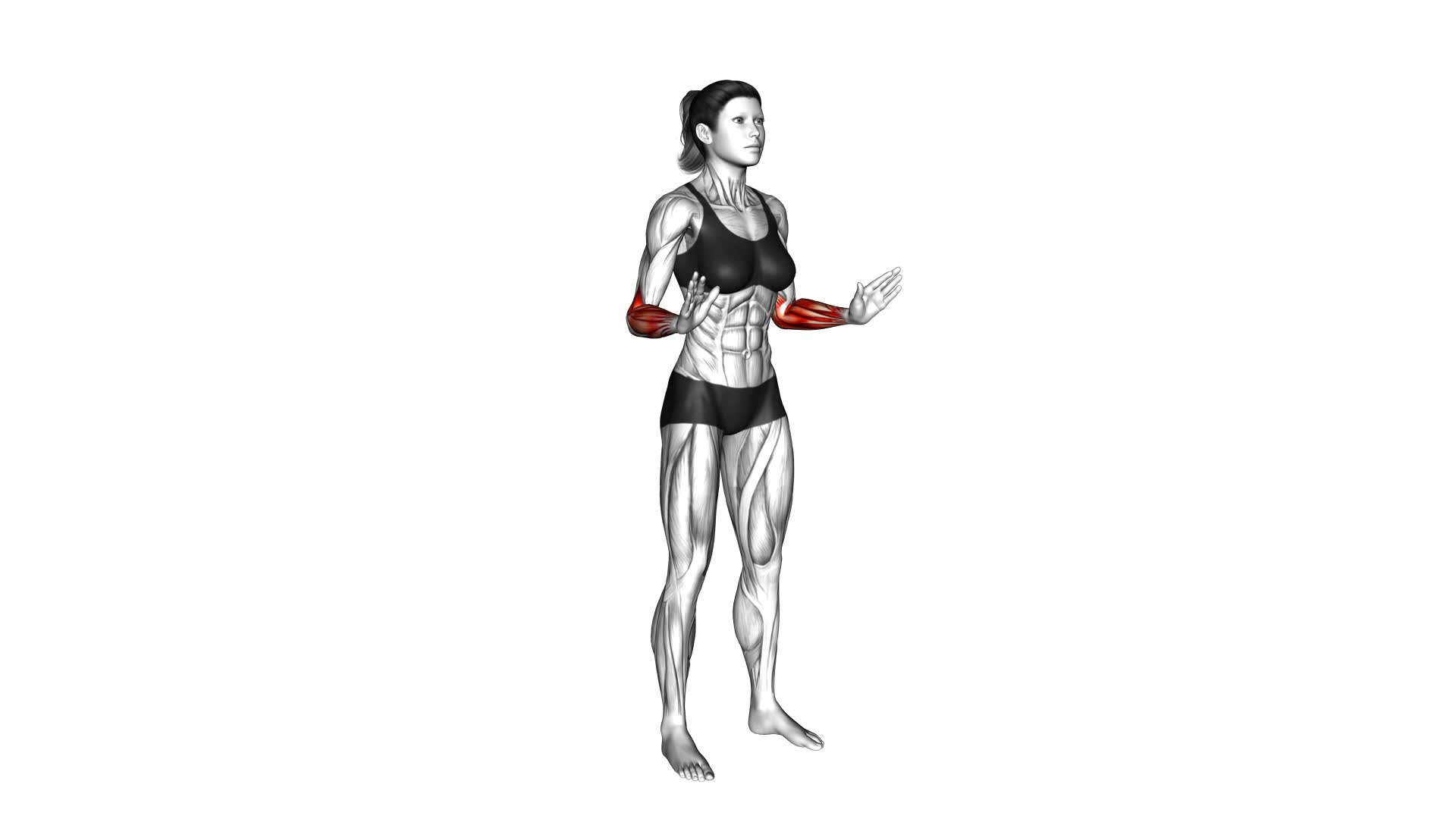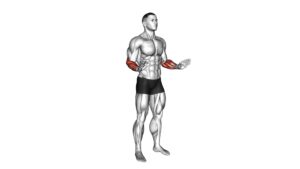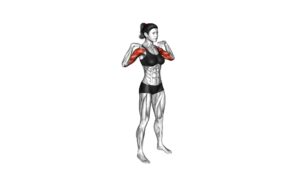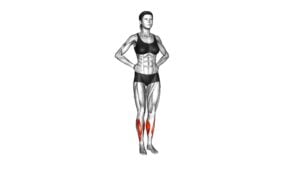Wrist Circles (female) – Video Exercise Guide & Tips

Are you looking for a quick and effective way to improve your wrist strength and flexibility? Look no further than wrist circles!
Watch This Exercise Video
In this video exercise guide, we will walk you through the step-by-step process of performing wrist circles, along with helpful tips to ensure proper form and technique.
Whether you're a fitness enthusiast or just want to prevent wrist injuries, this article is packed with everything you need to know.
Let's get started!
Key Takeaways
- Wrist circles improve wrist strength and flexibility.
- They promote blood flow and overall wrist health.
- Wrist circles reduce the risk of conditions like carpal tunnel syndrome and tendonitis.
- Incorporating wrist circles into an exercise routine can prevent injuries and strengthen wrist muscles.
Benefits of Wrist Circles for Women
You will experience improved wrist strength and flexibility by incorporating wrist circles into your exercise routine. Wrist flexibility is crucial for maintaining overall wrist health and preventing injuries. Regularly performing wrist circles can help increase the range of motion in your wrists, making them more flexible and adaptable to various movements.
When you perform wrist circles, you engage the muscles and tendons in your wrists, promoting blood flow and improving their overall health. This can help reduce the risk of conditions such as carpal tunnel syndrome and tendonitis.
Additionally, wrist circles can help strengthen the muscles in your wrists, including the flexor and extensor muscles. Strengthening these muscles can improve your grip strength and enhance your performance in activities that require wrist strength, such as weightlifting, yoga, and rock climbing.
Incorporating wrist circles into your exercise routine is simple. Start by extending your arms in front of you and making a fist with both hands. Slowly rotate your wrists in a circular motion, first clockwise and then counterclockwise. Aim to perform 10-15 repetitions in each direction, gradually increasing the number as your wrists become more flexible and stronger.
Step-by-Step Guide to Performing Wrist Circles
Performing wrist circles involves extending your arms in front of you and making a fist with both hands. This exercise is beneficial for improving wrist flexibility and hand mobility.
To begin, stand with your feet shoulder-width apart and relax your shoulders. Extend your arms straight out in front of you, parallel to the floor. Make a fist with both hands, keeping your wrists neutral.
Start by rotating your wrists in a clockwise direction, creating small circles. Gradually increase the size of the circles while maintaining control. After a few rotations, switch to counterclockwise circles. Remember to keep your movements smooth and controlled, avoiding any jerking or bouncing.
Perform 10 to 15 circles in each direction, and then rest. Repeat this exercise for a total of 2 to 3 sets.
Wrist circles are a simple yet effective exercise for improving wrist flexibility and hand mobility. Incorporate them into your routine to maintain healthy wrists and hands.
Tips for Proper Form and Technique
To ensure proper form and technique while performing wrist circles, it's important to keep your movements smooth and controlled, avoiding any jerking or bouncing. One common misconception is that wrist circles should be performed quickly and forcefully, but this can lead to strain and injury. Instead, focus on maintaining a slow and controlled pace throughout the exercise.
Another important aspect is the importance of wrist mobility. Wrist circles help to improve flexibility and strength in the wrists, which can be beneficial for various activities such as lifting weights, performing yoga poses, or even typing on a keyboard. By incorporating wrist circles into your exercise routine, you can enhance your overall wrist mobility and prevent injuries.
As you move on to the next section about modifications and progressions for wrist circles, remember to start with the basics and gradually increase the difficulty level to challenge your wrist strength and flexibility.
Modifications and Progressions for Wrist Circles
Continuing from the previous section on proper form and technique, let's explore ways to modify and progress wrist circles for an effective workout.
Modifying wrist circles can help accommodate different fitness levels or address specific needs. If you're a beginner or have limited wrist mobility, you can start with smaller circles and gradually increase the range of motion as your wrists become more flexible. This will allow you to gradually build strength and prevent any discomfort or strain.
To progress wrist circles and challenge yourself further, you can add resistance by using a light wrist weight or resistance band. This will increase the workload on your wrist muscles, promoting strength and stability.
Additionally, you can incorporate wrist mobility exercises and wrist stretches into your routine. These exercises can help improve flexibility and range of motion in your wrists, promoting better overall wrist health.
Remember to always listen to your body and modify the exercises as necessary. If you experience any pain or discomfort, it's important to stop and consult a healthcare professional.
Precautions and Common Mistakes to Avoid
As you progress with wrist circles, it's important to be aware of precautions and common mistakes to avoid. One of the common misconceptions is that wrist circles are a simple and easy exercise that can be done without caution. However, it's crucial to approach this exercise with care to prevent any potential injuries.
First and foremost, it's important to listen to your body and pay attention to any discomfort or pain. If you experience any pain during wrist circles, it's advised to stop immediately and consult a healthcare professional.
Additionally, it's important to avoid forcing the movement or applying excessive pressure on your wrists. Wrist circles should be done with gentle and controlled movements to avoid strain or injury.
Another common mistake to avoid is neglecting the importance of wrist mobility. Wrist circles aren't only a warm-up exercise but also a way to improve the flexibility and strength of your wrists. By neglecting this aspect, you may miss out on the benefits that wrist circles can provide.
Frequently Asked Questions
Can Men Also Perform Wrist Circles?
Yes, men can also perform wrist circles. Wrist circles are beneficial for both men and women. They help improve wrist mobility and flexibility.
By performing wrist circles regularly, you can strengthen the muscles in your wrists and reduce the risk of injury. Incorporating wrist circles into your exercise routine can also improve your grip strength and enhance your overall performance in activities that require wrist movement.
How Long Should I Perform Wrist Circles for to See Results?
To see results from wrist circles, you should perform them for a specific duration. Wrist circles can be done for about 5-10 minutes each day.
This exercise has several benefits, such as improving wrist mobility, reducing stiffness, and increasing blood flow to the area.
Can Wrist Circles Help With Carpal Tunnel Syndrome?
Wrist circles can indeed help with carpal tunnel syndrome. By regularly incorporating wrist circles into your routine, you can experience the benefits of improved overall wrist health.
To perform wrist circles effectively, start by extending your arm in front of you and rotating your wrist in a circular motion. Make sure to keep the movement controlled and gentle, avoiding any pain or discomfort.
Consistency is key, so aim for a few minutes of wrist circles each day to see positive results.
Are There Any Specific Warm-Up Exercises Recommended Before Performing Wrist Circles?
Before performing wrist circles, it's recommended to do specific warm-up exercises to prepare your wrists. These exercises can include gentle wrist flexion and extension, wrist rotations, and finger stretches.
By doing these warm-up exercises, you can increase blood flow to the wrists and loosen up the muscles, which can help prevent injuries and improve the effectiveness of wrist circles.
Incorporating warm-up exercises before wrist circles can maximize the benefits of this exercise for your wrist strength and flexibility.
Are There Any Alternative Exercises That Target the Same Muscle Groups as Wrist Circles?
If you're looking for alternative exercises that target the same muscle groups as wrist circles, there are a few options you can try.
One option is wrist curls, where you hold a dumbbell or a barbell and curl your wrist upwards.
Another option is wrist extensions, where you hold a weight and extend your wrist backwards.
Both exercises are effective for strengthening the muscles in your wrists and forearms.
Conclusion
In conclusion, wrist circles are a beneficial exercise for women as they help improve wrist flexibility and strength.
By following the step-by-step guide and practicing proper form and technique, women can effectively perform wrist circles.
It's important to start with gentle movements and gradually increase intensity to avoid any potential injuries.
Remember to listen to your body and make modifications or progressions as needed.
By practicing wrist circles with caution and consistency, women can enjoy the benefits of this exercise.

Author
Years ago, the spark of my life’s passion ignited in my mind the moment I stepped into the local gym for the first time. The inaugural bead of perspiration, the initial endeavor, the very first surge of endorphins, and a sense of pride that washed over me post-workout marked the beginning of my deep-seated interest in strength sports, fitness, and sports nutrition. This very curiosity blossomed rapidly into a profound fascination, propelling me to earn a Master’s degree in Physical Education from the Academy of Physical Education in Krakow, followed by a Sports Manager diploma from the Jagiellonian University. My journey of growth led me to gain more specialized qualifications, such as being a certified personal trainer with a focus on sports dietetics, a lifeguard, and an instructor for wellness and corrective gymnastics. Theoretical knowledge paired seamlessly with practical experience, reinforcing my belief that the transformation of individuals under my guidance was also a reflection of my personal growth. This belief holds true even today. Each day, I strive to push the boundaries and explore new realms. These realms gently elevate me to greater heights. The unique combination of passion for my field and the continuous quest for growth fuels my drive to break new ground.



